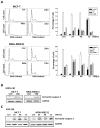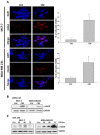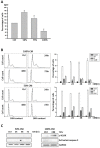Differential Response of Non-cancerous and Malignant Breast Cancer Cells to Conditioned Medium of Adipose tissue-derived Stromal Cells (ASCs)
- PMID: 31337963
- PMCID: PMC6643111
- DOI: 10.7150/ijms.27125
Differential Response of Non-cancerous and Malignant Breast Cancer Cells to Conditioned Medium of Adipose tissue-derived Stromal Cells (ASCs)
Abstract
Background: The application of adipose tissue-derived stromal cells (ASCs) in regenerative medicine has become a growing trend due to its abundance and differentiation potentials. However, several breast cancer studies indicated that ASCs promote tumor progression, therefore, the use of ASCs for reconstruction after oncological surgery poses potential risks. In this study, we aimed to examine whether cancerous or non-cancerous breast cells will exhibit different responses to ASC-derived CM. Methods: ASCs were isolated from residuals of subcutaneous adipose tissue obtained from patients undergoing surgery. Cancerous MCF-7, MDA-MB231, and MDA-MB468 cell lines and one non-cancerous M10/H184B5F5 cell line were cultured with variant concentrations of ASC-derived conditioned medium (CM) for analysis. Results: ASC-derived CM significantly reduced cell viability by triggering apoptosis in MCF-7, MDA-MB231, and MDA-MB468 cell lines. ATM-Chk2-dependent DNA damage response was activated early in cancer cells when exposed to ASC-derived CM. By contrast, prompted cell proliferation instead of cell death was detected in M10/H184B5F5 cells under the treatment of lower CM concentration. Even when exposed to the highest concentration of CM, only cell cycle arrest accompanied by a weak DNA damage response were detected in M10/H184B5F5 cells, no cell deaths were observed. Conclusions: Overall, this study demonstrated that cancerous and non-cancerous breast cells respond differently to ASC-derived CM. ASC-derived CM triggered significant cell death in breast cancer cell lines, however non-cancerous breast cells exhibited dissimilar response to ASC-derived CM.
Keywords: ASCs; adipose tissue-derived stromal cell; apoptosis; breast cancer cell line.
Conflict of interest statement
Competing Interests: The authors have declared that no competing interest exists.
Figures





Similar articles
-
Breast Cancer-Stromal Interactions: Adipose-Derived Stromal/Stem Cell Age and Cancer Subtype Mediated Remodeling.Stem Cells Dev. 2022 Oct;31(19-20):604-620. doi: 10.1089/scd.2021.0279. Epub 2022 Jul 12. Stem Cells Dev. 2022. PMID: 35579936 Free PMC article.
-
Human adipose tissue-derived stromal/stem cells promote migration and early metastasis of triple negative breast cancer xenografts.PLoS One. 2014 Feb 28;9(2):e89595. doi: 10.1371/journal.pone.0089595. eCollection 2014. PLoS One. 2014. PMID: 24586900 Free PMC article.
-
Adipose-derived stem cell-mediated paclitaxel delivery inhibits breast cancer growth.PLoS One. 2018 Sep 7;13(9):e0203426. doi: 10.1371/journal.pone.0203426. eCollection 2018. PLoS One. 2018. PMID: 30192811 Free PMC article.
-
Adipose Tissue-Derived Stem Cell Therapy for Post-Surgical Breast Reconstruction--More Light than Shadows.Adv Clin Exp Med. 2015 May-Jun;24(3):545-8. doi: 10.17219/acem/31673. Adv Clin Exp Med. 2015. PMID: 26467147 Review.
-
Potential application of adipose-derived stem cells and their secretory factors to skin: discussion from both clinical and industrial viewpoints.Expert Opin Biol Ther. 2010 Apr;10(4):495-503. doi: 10.1517/14712591003610598. Expert Opin Biol Ther. 2010. PMID: 20218919 Review.
Cited by
-
TGF-B1-over-expressed adipose stem cells-derived secretome exhibits CD44 suppressor and anti-cancer properties via antagonistic effects against SMAD4 in breast cancer cells.Am J Stem Cells. 2022 Dec 25;11(5):64-78. eCollection 2022. Am J Stem Cells. 2022. PMID: 36660741 Free PMC article.
-
Adipose tissue-derived stem cells in breast reconstruction: a brief review on biology and translation.Stem Cell Res Ther. 2021 Jan 6;12(1):8. doi: 10.1186/s13287-020-01955-6. Stem Cell Res Ther. 2021. PMID: 33407902 Free PMC article. Review.
-
The novel roles of YULINK in the migration, proliferation and glycolysis of pulmonary arterial smooth muscle cells: implications for pulmonary arterial hypertension.Biol Res. 2023 Dec 7;56(1):66. doi: 10.1186/s40659-023-00480-z. Biol Res. 2023. PMID: 38057829 Free PMC article.
-
Breast fat grafting and cancer: a systematic review of the science behind enhancements and concerns.Transl Breast Cancer Res. 2024 Apr 29;5:14. doi: 10.21037/tbcr-23-54. eCollection 2024. Transl Breast Cancer Res. 2024. PMID: 38751673 Free PMC article. Review.
-
Lipofilling in Breast Oncological Surgery: A Safe Opportunity or Risk for Cancer Recurrence?Int J Mol Sci. 2021 Apr 3;22(7):3737. doi: 10.3390/ijms22073737. Int J Mol Sci. 2021. PMID: 33916703 Free PMC article. Review.
References
-
- Zuk PA, Zhu M, Mizuno H. et al. Multilineage cells from human adipose tissue: Implications for cell-based therapies. Tissue Eng. 2001;7:211–228. - PubMed
-
- Xu WT, Bian ZY, Fan QM. et al. Human mesenchymal stem cells (hMSCs) target osteosarcoma and promote its growth and pulmonary metastasis. Cancer Lett. 2009;281:32–41. - PubMed
MeSH terms
Substances
LinkOut - more resources
Full Text Sources
Medical
Research Materials
Miscellaneous

